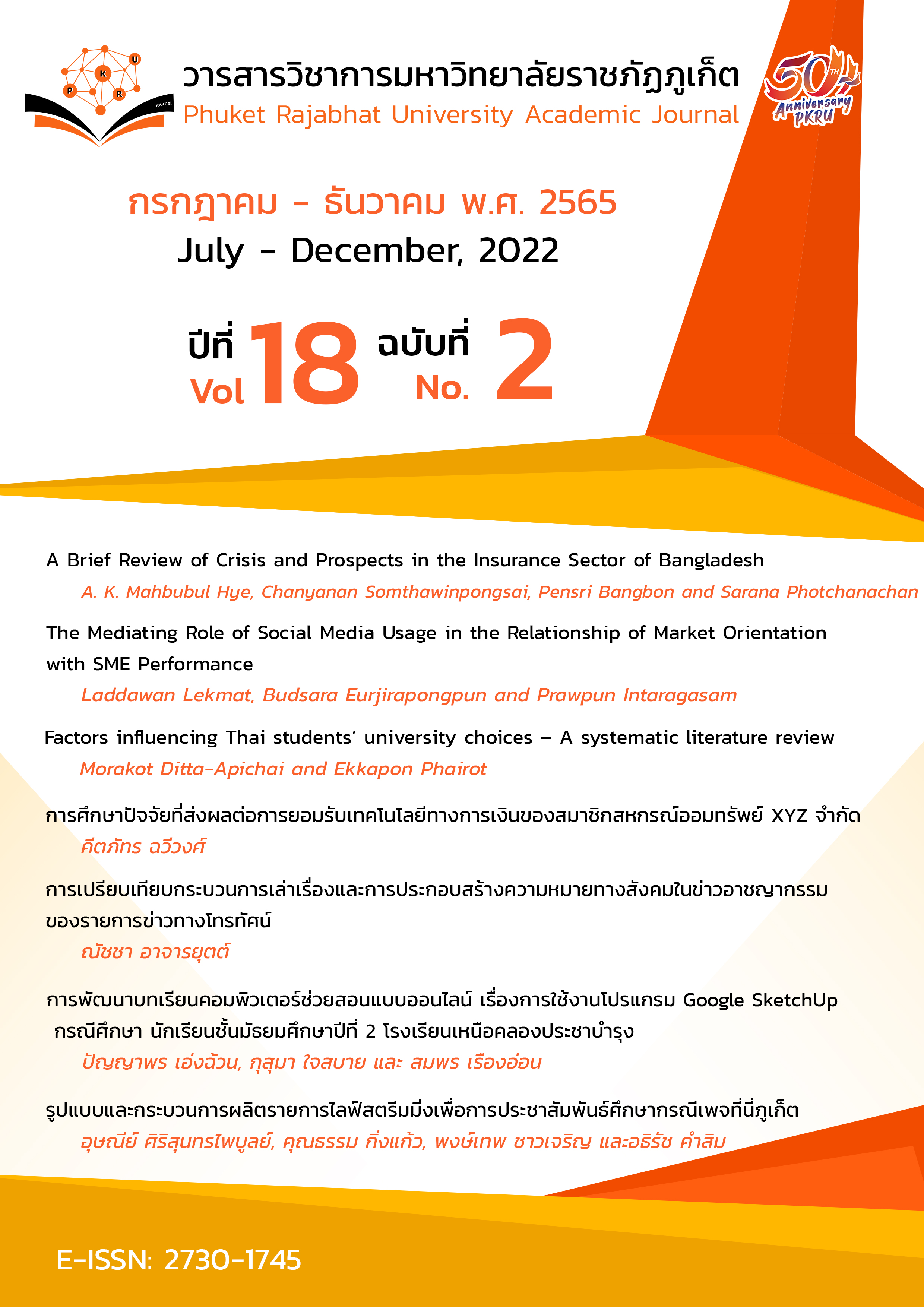การศึกษาปัจจัยที่ส่งผลต่อการยอมรับเทคโนโลยีทางการเงินของสมาชิกสหกรณ์ ออมทรัพย์ XYZ จำกัด
Main Article Content
บทคัดย่อ
เทคโนโลยีดิจิทัลเป็นกลไกสำคัญที่ทุกองค์กรนำมาประยุกต์ใช้กับการดำเนินงานตั้งแต่หน้าที่พื้นฐานขององค์กรจนถึงการส่งมอบคุณค่าให้แก่ลูกค้า เพื่อเป็นการสร้างกลยุทธ์ด้านการแข่งขันและเพิ่มประสิทธิภาพในการดำเนินงานขององค์กร งานวิจัยนี้มีวัตถุประสงค์เพื่อศึกษาปัจจัยที่ส่งผลต่อการยอมรับเทคโนโลยีทางการเงินของสมาชิกสหกรณ์ออมทรัพย์ XYZ จำกัด โดยเก็บข้อมูลจากกลุ่มตัวอย่าง จำนวน 136 ราย ที่เคยทำธุรกรรมผ่านแอปพลิเคชันสหกรณ์ออมทรัพย์ XYZ จำกัด และวิเคราะห์ข้อมูลด้วยการวิเคราะห์การถดถอยพหุคูณ (Multiple Regression Analysis) ผลการวิจัยพบว่า ทัศนคติและการรับรู้ความเชื่อมั่นมีอิทธิพลเชิงบวกอย่างมีนัยสำคัญทางสถิติ ส่วนการรับรู้ความเสี่ยงมีอิทธิพลเชิงลบอย่างมีนัยสำคัญทางสถิติต่อการยอมรับเทคโนโลยีทางการเงินของสมาชิกสหกรณ์ออมทรัพย์ XYZ จำกัด ดังนั้นสหกรณ์ผู้ให้บริการควรให้้ความสำคัญกับสร้างภาพลักษณ์ ความเชื่อมั่น รวมถึงการสื่อถึงความเสี่ยงจากการใช้เทคโนโลยีทางการเงิน เพื่อสร้างให้ผู้ใช้งานเกิดความเชื่อถือในการเพิ่มประสิทธิภาพของเทคโนโลยีทางการเงิน
Article Details

อนุญาตภายใต้เงื่อนไข Creative Commons Attribution-NonCommercial-NoDerivatives 4.0 International License.
เนื้อหาและข้อมูลในบทความที่ลงตีพิมพ์ในวารสารวิชาการมหาวิทยาลัยราชภัฏภูเก็ต ถือเป็นข้อคิดเห็นและความรับผิดชอบของผู้เขียนบทความโดยตรง ซึ่งกองบรรณาธิการวารสารฯ ไม่จำเป็นต้องเห็นด้วยหรือร่วมรับผิดชอบใด ๆ
บทความ ข้อมูล เนื้อหา รูปภาพ ฯลฯ ที่ได้รับการตีพิมพ์ในวารสารวิชาการมหาวิทยาลัยราชภัฏภูเก็ต ถือเป็นลิขสิทธิ์ของวารสารวิชาการมหาวิทยาลัยราชภัฏภูเก็ต หากบุคคลหรือหน่วยงานใดต้องการนำทั้งหมดหรือส่วนหนึ่งส่วนใดไปเผยแพร่ต่อหรือเพื่อกระทำการใด ๆ จะต้องได้รับอนุญาตเป็นลายลักษณ์อักษรจากวารสารวิชาการมหาวิทยาลัยราชภัฏภูเก็ตก่อนเท่านั้น
เอกสารอ้างอิง
Aboelmaged, M., & Gebba, T. R. (2013). Mobile Banking Adoption: An Examination of Technology Acceptance Model and Theory of Planned Behavior. International Journal of Business Research and Development, 2(1), 35-50. https://doi.org/10.24102/ijbrd.v2i1.263
Bank of Thailand. (2019). The Overview of FinTech and Thai financial system. Retrieved September 15th, 2021, from https://www.bot.or.th/Thai/BOTMagazine/Documents//PhraSiam0362/CoverStory_FinTech.pdf
Bank of Thailand. (2021). Money supply and composition. Retrieved September 15th, 2021, from https://www.bot.or.th/App/BTWS_STAT/statistics/BOTWEBSTAT.aspx?reportID=7&language=th
Barakat, A., & Hussainey, K. (2013). Bank governance, regulation, supervision, and risk reporting: Evidence from operational risk disclosures in European banks. International Review of Financial Analysis, 30, 254–273. https://doi.org/10.1016/j.irfa.2013.07.002
Chen, L., & Aklikokou, A. K. (2020). Determinants of E-government Adoption: Testing the Mediating Effects of Perceived Usefulness and Perceived Ease of Use. International Journal of Public Administration, 43(10), 850–865. https://doi.org/10.1080/01900692.2019.1660989
Chong, A., Ooi, K., Lin, B., & Tan, B. (2010). Online banking adoption: An empirical analysis. International Journal of Bank Marketing, 28(4), 267–287. https://doi.org/10.1108/026 52321011054963
Chuang, L.-M., Liu, C.-C., & Kao, H.-K. (2016). The Adoption of Fintech Service: TAM perspective. International Journal of Management and Administrative Sciences, 3(7), 1-15.
Cooperative Promotion Department. (2021) Summary of cooperative business volume for the year 2021. Retrieved September 15th, 2021, from https://drive.google.com/file/d/1YKbLk6xK3mzgQc_fVg9QU5hUy9qEB8Fb/view
Davis, F. D., Bagozzi, R. P., & Warshaw, P. R. (1989). User Acceptance of Computer Technology: A Comparison of Two Theoretical Models. Management Science, 35(8), 982–1003. https://doi.org/10.1287/mnsc.35.8.982
Fishbein, M., & Ajzen, I. (1975). Belief, Attitude, Intention and Behavior: An Introduction to Theory and Research. Addison Wesley, Reading.
Green, S. B. (1991). How Many Subjects Does It Take To Do A Regression Analysis. Multivariate Behavioral Research, 26(3), 499–510. https://doi.org/10.1207/s15327906mbr2603_7
Hair, J. F., Black, W. C., Babin, B. J. & Anderson, R. E. (2010). Multivariate Data Analysis 7th ed. Prentice Hall.
Hair, J. F., Black, W. C., Babin, B. J. & Anderson, R. E. (2019). Multivariate data analysis. 8th ed. Andover, Hampshire.: Cengage Learning.
Hu, Z., Ding, S., Li, S., Chen, L., & Yang, S. (2019). Adoption Intention of Fintech Services for Bank Users: An Empirical Examination with an Extended Technology Acceptance Model. Symmetry, 11(3), 340.
Hubert, M., Blut, M., Brock, C., Backhaus, C., & Eberhardt, T. (2017). Acceptance of Smartphone-Based Mobile Shopping: Mobile Benefits, Customer Characteristics, Perceived Risks, and the Impact of Application Context: Acceptance Of Smartphone-Based Mobile Shopping. Psychology & Marketing, 34(2), 175–194. https://doi.org/10.1002/mar.20982
Jampangoen, P. (2019). Fintech Stream to Techfin: Financial Regulatory Challenges Driven with Big Data of Thai Financial Industry. Ph.D. in Social Sciences Journal, 9(3), 573-583.
Koundinya, C. (2019). Predicting Online Travel Adoption Intention of an Indian Consumer: A SEM-Neural Network Approach. Theoretical Economics Letters, 9(2), 348–375. https:// doi.org/10.4236/tel.2019.92026
Ng, A. W., & Kwok, B. K. B. (2017). Emergence of Fintech and cybersecurity in a global financial centre: Strategic approach by a regulator. Journal of Financial Regulation and Compliance, 25(4), 422–434. https://doi.org/10.1108/JFRC-01-2017-0013
Office of the National Economics and Social Development Council. (2016). The Twelfth National Economic and Social Development Plan (2017-2021). Retrieved September9th, 2021, from https://www.nesdc.go.th/ewt_dl_link.php?nid=6422.
Pehunhachinda, P. (2017). Fintech: Towards Thailand 4.0. Electronic Journal of Open and Distance Innovative Learning, 7(1), 1-23.
Royal forest department savings and credit cooperative limited. (2020). CO-OP Digital 2020 To the new cooperative era...it’s just your fingertips.Retrieved September 15, 2021, from https://www.025798899.com/news/1712.
Ryu, H.-S. (2018). Understanding Benefit and Risk Framework of Fintech Adoption: Comparison of Early Adopters and Late Adopters. Proceedings of the 51st Hawaii International Conference on System Sciences, Hilton Waikoloa Village, Hawaii, USA.
Saengchote, T., & Distanont, A. (2018). FinTech Adoption of MyMo Mobile Banking in Government Saving Bank. Suan Dusit Graduate School Academic Journal. 15(3), 47-64
Shaikh, A. A., & Karjaluoto, H. (2015). Mobile banking adoption: A literature review. Telematics and Informatics, 32(1), 129–142. https://doi.org/10.1016/j.tele.2014.05.003
Siau, K., & Wang, W. (2018). Building Trust in Artificial Intelligence, Machine Learning, and Robotics. Cutter business technology journal, 31(2), 47-53
Stewart, H., & Jürjens, J. (2018). Data security and consumer trust in FinTech innovation in Germany. Information & Computer Security, 26(1), 109–128. https://doi.org/10.1108/ICS-06-2017-0039
Thanabordeekij, P., Sudtasan, T., & Tanamee, D. (2020). Integrating trust into the technology acceptance model: the case of mobile banking adoption in Myanmar. Panyapiwat Journal, 12(3), 107-119.
Vaicondam, Y., Jayabalan, N., Tong, C. X., Qureshi, M. I., & Khan, N. (2021). Fintech Adoption Among Millennials in Selangor. Academy of Entrepreneurship Journal, 27(5), 1-14.
Wangyen, S. (2020). Factors affecting technology adoption used for processing accounting data a case study of the federation of thai industries officials. [Master's thesis]. Dhurakij Pundit University
Zhang, T., Tao, D., Qu, X., Zhang, X., Lin, R., & Zhang, W. (2019). The roles of initial trust and perceived risk in public’s acceptance of automated vehicles. Transportation Research Part C: Emerging Technologies, 98, 207–220. https://doi.org/10.1016/j.trc.2018.11.018
Zhong, L., Zhang, X., Rong, J., Chan, H. K., Xiao, J., & Kong, H. (2021). Construction and empirical research on acceptance model of service robots applied in hotel industry. Industrial Management & Data Systems, 121(6), 1325–1352. https://doi.org/10.1108/IMDS-11-2019-0603


